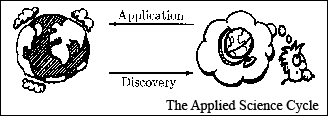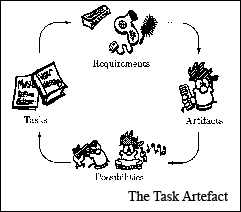
June 2010 Edition
Computer Science Department, University of Cape Town
| MIT Notes Home | Edition Home |
 | MSc-IT Study Material June 2010 Edition Computer Science Department, University of Cape Town | MIT Notes Home | Edition Home | |
Obtain a good software engineering textbook (e.g. ‘Software Engineering’ by S. R. Schach, 1993, published by Irwin and Associates. A search for ‘software engineering’ on any technical library catalogue should bring up a wealth of good text books.) and investigate some of the design processes other than the waterfall model. Discuss the implications of user centred design for those process. Do those processes make user centred design easier or not? Why?
In particular you might wish to investigate the ‘Delta model’ which is held to be particularly adept at incorporating user centred design. What makes this so?
Newton predicted that if you dropped a hammer and a feather in a vacuum they would fall at the same rate. This is because gravity pulls on objects consistently, independent of their mass. The only reason that hammers and feathers fall at different rates is because of friction with the air. Remove the air and they fall at the same rate. Newton was able to make this prediction based on a thorough and correct (not withstanding Einstein and relativity) understanding of the science of gravity. It was not until some hundreds of year later that an Apollo astronaut actually took a feather and hammer and dropped them on the moon that we actually had evidence that Newton was correct.
There is an equivalent question for HCI; do we understand users and user behaviour enough that we can predict how they will behave with an interactive system? If we do, then we can design for usability because we can predict user behaviour, but if we cannot then the best we can do is build a system, give it to users and see what they do with it.
Barnard (1991) suggests the ‘Applied Science Cycle’ shown in figure 1. There is a ‘real world’ of tangible objects and observable behaviours and an ‘abstract world’ of scientific theories about the sort of things that go on in the real world. A scientific theory is held to be a good if it manages to accurately predict what goes on in the real world. (Newton’s theories of gravity are good, even though they have been supplanted by Einstein’s theories. Newton is accurate when describing gravity as experienced by those who are not approaching the speed of light. As most of us rarely approach the speed of light then Newton’s theories are good for us.)

Barnard argues that things go on in the real world and that scientists observe them and think up theories to account for them. This translation from the real world to the abstract is called ‘discovery’. Designers can use the theories in the abstract world to design artefacts in the real world. This translation from the abstract world to the real world is called ‘application’.
Applying Barnard’s cycle to HCI, we have a world view whereby people who study human behaviour (psychologists and sociologists) observe and analyse human behaviour and develop theories about their behaviour (discovery). Interactive system designers can then apply these theories to help them better design their systems (application).

Carroll et al (1991) rejects Barnard’s cycle on the grounds that is inappropriate for designing interactive systems. He argues that human behaviour is simply too complex to usefully abstract over and therefore the discovery translation of the applied science cycle is worthless.
Carroll suggests a replacement for the applied science cycle called the ‘Task-artefact cycle’ shown in figure 2. It is rather more subtle than Barnard’s cycle so we have shown it with an example.
We start with artefacts; tools for doing a job. Here the tool we consider is a comb. A tool offers possibilities, and those possibilities may not be the ones for which it was originally designed. In the case of the comb it may be used for combing hair, or it may be wrapped in paper and played as a musical instrument. This gives us new tasks. From these tasks we can gather requirements from users about how they may wish to do their tasks better, in the case of the comb the user may require a harmonica if they wish to concentrate on their musical skills or better hair dressing tools if they stick to the comb’s original purpose.
Central to Carroll’s cycle is the notion of artefacts, whereas central to Barnard’s cycle is abstract theories. Carroll therefore argues that his cycle is more practical and better reflects design practice in the real world. However Carroll’s argument is that you must produce something and set it in the real world before you will be able to usefully understand how it is used. Taken to its logical conclusion Carroll’s argument is for throwing mud against walls.
Barnard’s argument should not really interpreted as a description of how things are, but how they should be. Useful and accurate theories of human computer interaction mean that systems can be designed based on those theories, by anyone who understands them.
The counter argument to theory based HCI is that of ‘craft skill’. A craft skill is something that cannot be caught in a theory. Most artistic endeavours rely on craft skill. (Actually most scientists think that artistic endeavours rely on craft skill – when analysed most artists have a plethora of theories and rules which determine what they do.) Many HCI practitioners work as ‘craft skill’ experts; they will inform designers about what makes a good or bad interactive system, but the rationale behind their arguments is unclear and ill-formed. They have knowledge about HCI, but not in a form that is expressible. Hence they do not advance HCI as a science.
Carroll’s arguments, particularly the argument that human behaviour cannot be abstracted over, lean towards HCI as a craft skill. It is not clear how a designer goes from ‘requirements’ in his cycle to ‘artefacts’ other than by applying craft skill.
There is a well researched theory known as Fitt’s Law (1954), developed by a psychologist. It describes very accurately the time it takes for the hand to move a certain distance and hit a target area. This law is very useful for designing buttons in graphical user interfaces (see Dix et al, page 252). It allows the designer to analyse the size and spacing of buttons and predict how easily the user (with the mouse) can press them.
Fitt’s Law is a classic example of a discovery on Barnard’s cycle which can be usefully applied. There are other examples of psychological theory which can be used to predict user behaviour. May, Scott and Barnard (1996) have developed theories of perception which predict how well users will be able to pick out icons on screen.
These ‘small granularity’ theories abound in psychology, describing hand to eye co-ordination, perception, our ability to think about two things at once, our ability to reason logically, etc.
Sociology looks at human behaviour at a much larger ‘granularity’, describing human group behaviour, particularly of interest to HCI is ‘work theory’ which describes how we go about doing our jobs and fulfilling tasks.
HCI sits between psychology and sociology. Interactive systems are seen as tools in work, so HCI is smaller scale than most sociology theories, but larger than most theories propounded in psychology. There are theories of HCI but they are not as well researched and established as those drawn from psychology and sociology. Also they are not clearly or abstractly set out as theories (at least not as abstractly set out as Fitt’s Law, which is one mathematical equation) or as general as could be hoped.
In this extension unit we have dealt with some fairly lofty ideas about scientific validity and the use of science in design. The aim of the extension is to argue that we can design for usability, rather than just test for usability. We believe that it is possible and desirable to design for usability, although this approach is contentious.